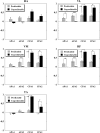Aging and balance control in response to external perturbations: role of anticipatory and compensatory postural mechanisms
- PMID: 24532389
- PMCID: PMC4082574
- DOI: 10.1007/s11357-014-9621-8
Aging and balance control in response to external perturbations: role of anticipatory and compensatory postural mechanisms
Abstract
The ability to maintain balance deteriorates with increasing age. Anticipatory and compensatory postural adjustments (APAs and CPAs, respectively), both, are known to be affected in the elderly. We examined the effect of aging on the ability of older adults to utilize APAs and its effect on subsequent control of posture (CPAs). Ten elderly individuals were exposed to external predictable and unpredictable perturbations applied to the upper body in the sagittal plane. Body kinematics, electromyographic activity of 13 muscles, and ground reaction forces were analyzed during the anticipatory and compensatory phases of postural control. The elderly were capable of recognizing an upcoming predictable perturbation and activated muscles prior to it. However, the older adults used different muscle strategies and sequence of muscle recruitment than that reported in young adults. Additionally, when the perturbations were unpredictable, no APAs were seen which resulted in large CPAs and greater peak displacements of the center of pressure (COP) and center of mass (COM) following perturbations. As opposed to this, when the perturbations were predictable, APAs were seen in older adults resulting in significantly smaller CPAs. The presence and utilization of APAs in older adults also improved postural stability following the perturbation as seen by significantly smaller COP and COM peak displacements. Using APAs in older adults significantly reduces the need for large CPAs, resulting in greater postural stability following a perturbation. The results provide a foundation for investigating the role of training in improving the interplay between anticipatory and compensatory postural control in older adults.
Figures




Similar articles
-
The role of anticipatory postural adjustments in compensatory control of posture: 1. Electromyographic analysis.J Electromyogr Kinesiol. 2010 Jun;20(3):388-97. doi: 10.1016/j.jelekin.2009.06.006. Epub 2009 Aug 5. J Electromyogr Kinesiol. 2010. PMID: 19660966
-
The role of anticipatory postural adjustments in compensatory control of posture: 2. Biomechanical analysis.J Electromyogr Kinesiol. 2010 Jun;20(3):398-405. doi: 10.1016/j.jelekin.2010.01.002. Epub 2010 Feb 13. J Electromyogr Kinesiol. 2010. PMID: 20156693 Free PMC article.
-
The effect of aging on anticipatory postural control.Exp Brain Res. 2014 Apr;232(4):1127-36. doi: 10.1007/s00221-014-3822-3. Epub 2014 Jan 22. Exp Brain Res. 2014. PMID: 24449006 Free PMC article.
-
Anticipatory and compensatory postural adjustments in people with low back pain: a systematic review and meta-analysis.Spine J. 2018 Oct;18(10):1934-1949. doi: 10.1016/j.spinee.2018.06.008. Epub 2018 Jun 12. Spine J. 2018. PMID: 29906616
-
Anticipatory postural adjustments in older versus young adults: a systematic review and meta-analysis.Syst Rev. 2022 Nov 23;11(1):251. doi: 10.1186/s13643-022-02116-x. Syst Rev. 2022. PMID: 36419140 Free PMC article.
Cited by
-
Examining the influence of body fat distribution on standing balance and functional performance in overweight female patients with degenerative lumbar disease.Front Bioeng Biotechnol. 2024 Jun 21;12:1375627. doi: 10.3389/fbioe.2024.1375627. eCollection 2024. Front Bioeng Biotechnol. 2024. PMID: 38974656 Free PMC article.
-
Influence of vision on gait initiation and first step kinematics in young and older adults.Physiol Res. 2021 Dec 31;70(S3):S409-S417. doi: 10.33549/physiolres.934813. Physiol Res. 2021. PMID: 35099259 Free PMC article.
-
Enhancement of anticipatory postural adjustments in older adults as a result of a single session of ball throwing exercise.Exp Brain Res. 2015 Feb;233(2):649-55. doi: 10.1007/s00221-014-4144-1. Epub 2014 Nov 26. Exp Brain Res. 2015. PMID: 25424864
-
Enhancing Anticipatory Postural Adjustments: A Novel Approach to Balance Rehabilitation.J Nov Physiother. 2016 Apr;6(2):e144. doi: 10.4172/2165-7025.1000e144. Epub 2016 Apr 29. J Nov Physiother. 2016. PMID: 27335705 Free PMC article.
-
Graceful gait: virtual ballet classes improve mobility and reduce falls more than wellness classes for older women.Front Aging Neurosci. 2024 Jan 24;16:1289368. doi: 10.3389/fnagi.2024.1289368. eCollection 2024. Front Aging Neurosci. 2024. PMID: 38327499 Free PMC article.
References
-
- Bazalgette D, Zattara M, Bathien N, Bouisset S, Rondot P. Postural adjustments associated with rapid voluntary arm movements in patients with Parkinson’s disease. Adv Neurol. 1987;45:371–374. - PubMed
-
- Belen’kii VE, Gurfinkel VS, Pal’tsev EI. Control elements of voluntary movements. Biofizika. 1967;12:135–141. - PubMed
Publication types
MeSH terms
Grants and funding
LinkOut - more resources
Full Text Sources
Other Literature Sources
Medical
Research Materials
